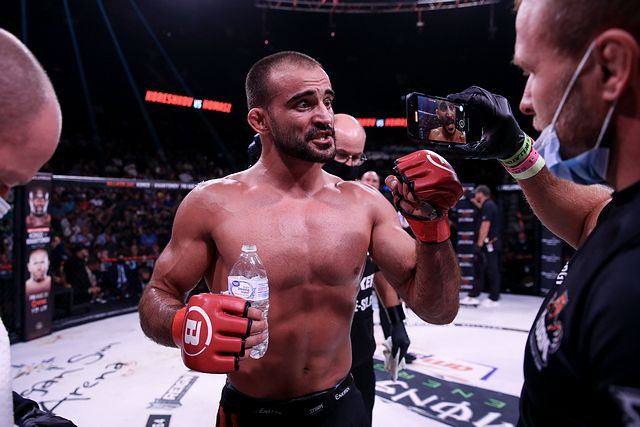The Bottom Line: Drawing Parallels
Editor’s note: The views and opinions expressed below are those of the author and do not necessarily reflect the views of Sherdog.com, its affiliates and sponsors or its parent company, Evolve Media.
Many if not most of the Ultimate Fighting Championship’s all-time biggest superstars burst onto the scene with an immediate impact. Ronda Rousey had already made her name in Strikeforce, and she was introduced as a pay-per-view headliner against Liz Carmouche before going on to main event some of the UFC’s biggest events. Brock Lesnar likewise was a well-known commodity from his time in World Wrestling Entertainment, and his fight with Frank Mir was hotly anticipated. Lesnar was an attraction every time he fought in the UFC.
Advertisement
It’s perhaps counterintuitive given how many fighters we see struggle for years to gain mainstream recognition, but MMA’s top attractions generally have attained that status without a ton of difficulty. The path of the fighter who earns everything slowly before achieving genuine stardom is much less common. Chuck Liddell is the most prominent example, working his way up the ranks for years before finally getting his star-making fight with training partner turned rival Tito Ortiz.
Brian
Ortega, if he becomes a fixture at the top of the featherweight
division, clearly fits into the second category. Ortega didn’t come
into the UFC with a lot of hype. He was coming off a split decision
win in the
Resurrection Fighting Alliance when he got his UFC opportunity,
and a drug test failure took the shine off what was originally a
debut victory. Ortega’s calling card became that he would fall
behind in fights only to pull off the win late. It was often
exciting to see, but it didn’t inspire confidence that this was a
fighter fans needed to take note of.
As Ortega started to get more prominent fights, he was still viewed as the B-side. Ortega was the betting underdog for his last three fights, and he’s likely to be the underdog for his next fight, as well. Ortega is earning respect incrementally. His performances are improving even as he fights stiffer competition. Ortega is the rare fighter who scores more finishes as he moves up in class, going from winning decisions to scoring submissions and knockouts.
Ortega’s knockout of Frankie Edgar at UFC 222 felt like it might be his coming-out party. Edgar has fought a who’s who of the lighter weight classes and had never been stopped before. If that fight marks a new stage in the career of the future hall of famer, it will likely boost Ortega’s reputation even further. However, there’s still work to do, as Ortega has a big obstacle in front of him in UFC featherweight champion Max Holloway.
What’s intriguing about the Holloway-Ortega title showdown is that if there’s anyone in the division who understands Ortega’s grind, it’s Holloway. Like Ortega, Holloway worked at converting doubters one fight at a time. Early losses to Dustin Poirier, Dennis Bermudez and Conor McGregor threw many off the scent of Holloway as a potential factor at 145 pounds. No one suspected when Holloway lost to McGregor that he wouldn’t lose again for over four years.
Like Ortega, Holloway’s wins were at first rather non-descript. It wasn’t that he wasn’t winning impressively, because he was. It’s just that he was perceived at a certain level, and it took time to overcome that perception. Like Ortega, a win over Cub Swanson helped elevate Holloway to a higher level. Ricardo Lamas and Anthony Pettis were additional strong wins, but Holloway was still the underdog heading into his first fight with Jose Aldo. It was only after the Aldo fights that Holloway started getting the recognition he deserves.
Ortega is in a similar predicament to Holloway before that first Aldo fight. Until Ortega proves he can beat the champion, most are unlikely to believe he will. Of course, that’s no problem for “T-City.” He has spent his whole career defying expectations. Holloway charted the same course. The underdog kept winning until he was no longer the underdog. Ortega now will have the chance to complete that same transformation. Underdog status is only lost through winning.
Todd Martin has written about mixed martial arts since 2002 for a variety of outlets, including CBSSports.com, SI.com, ESPN.com, the Los Angeles Times, MMApayout.com, Fight Magazine and Fighting Spirit Magazine. He has appeared on a number of radio stations, including ESPN affiliates in New York and Washington, D.C., and HDNet’s “Inside MMA” television show. In addition to his work at Sherdog.com, he does a weekly podcast with Wade Keller at PWTorch.com and blogs regularly at LaTimes.com. Todd received his BA from Vassar College in 2003 and JD from UCLA School of Law in 2007 and is a licensed attorney. He has covered UFC, Pride, Bellator, Affliction, IFL, WFA, Strikeforce, WEC and K-1 live events. He believes deeply in the power of MMA to heal the world and bring happiness to all of its people.
Related Articles







